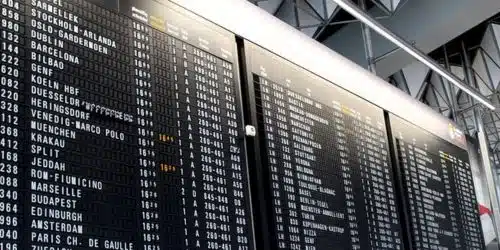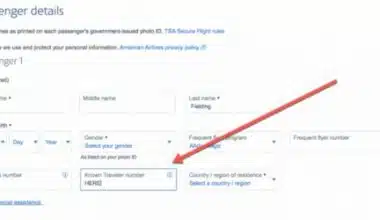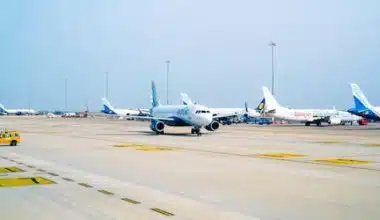A flight number appears on a ticket, boarding permits, and airport monitors and is an essential element of air travel. But have you ever thought about what they actually mean? In this detailed guide, we’ll delve into the realm of flight numbers, revealing their significance and shining light on their purpose and example. We’ll go over everything you need to know about flight numbers, from their structure to their meanings. So buckle your seatbelts, and let’s take off!
What is a Flight Number?
Flight numbers are alphanumeric designations that airlines allocate to specific flights. They act as unique identifiers, allowing one flight to be distinguished from another. But what do these figures actually mean? Let’s get into the details.
Every flight number is made up of letters and/or numbers that normally range from one to four digits. The format varies among airlines, but it generally follows a constant pattern. For example, a flight number could be “AA123” or “DL4567.” The letters in the flight number frequently signify the airline’s code or an IATA (International Air Transport Association) airline designator, while the digits represent the specific flight.
Decoding the Airline Code
A flight number’s letters are frequently obtained from the airline’s code or IATA airline designator. IATA standardizes and assigns these numbers to each airline, assuring global recognition and uniformity.
For example, if you see a flight number like “DL123,” the “DL” stands for Delta Air Lines’ airline code. Similarly, “AA123” denotes American Airlines. These airline codes make it easier to identify airlines, especially when numerous carriers fly to the same destination.
Unveiling Flight Sequence Numbers
The numbers in a flight number represent the specific flight within an airline’s schedule. They are commonly referred to as flight sequence numbers, and they serve an important role in identifying a certain flight among the airline’s operations.
Within an airline’s schedule, flight sequence numbers normally follow a chronological order. For example, “DL123” might signify that it is the 123rd flight on Delta Air Lines’ timetable. It is crucial to note, however, that flight numbers are not always assigned sequentially. Airlines can assign flight numbers in a variety of ways, such as grouping flights based on routes or operational considerations.
Flight Number Flexibility and Use
Flight numbers might change for a variety of reasons, including schedule changes, aircraft changes, or operational requirements. Airlines have the ability to change flight numbers to accommodate their operations while guaranteeing a pleasant customer experience.
For example, if a flight is rescheduled to depart at a later time, the airline may assign a new flight number to reflect the revised schedule. Similarly, if an aircraft is replaced or a flight is joined with another, the flight number may be changed to reflect the new operation.
Aside from standard flight numbers, there are flight numbers linked to regional flights and codeshare agreements. Let’s look at these differences and their implications.
- Regional Flight Numbers: Some airlines operate regional flights under different branding or as subsidiaries. In such circumstances, regional flight numbers may differ from mainline flight numbers. This distinction assists travelers in identifying the exact operating carrier and distinguishing between several flight alternatives.
- Codeshare Flight Numbers: Codeshare agreements allow airlines to sell tickets on partner airline flights. In cases of codesharing, the flight number may appear to belong to one airline even though another carrier is actually operating the flight. This agreement enables airlines to expand their networks and provide passengers with more destinations.
Flight Status and Flight Numbers
Flight numbers are essential for tracking and monitoring flight status. Understanding the structure of a flight number can provide you with significant information about the origin, destination, and operating carrier of an aircraft.
For example, if you see a flight number on an airport monitor, such as “DL123,” you can deduce that it is a Delta Air Lines flight and identify the appropriate departure gate. Similarly, while checking the status of a flight online or via mobile apps, the flight number serves as a reference point for real-time updates on arrival and departure schedules, gate changes, and probable delays.
Flight Number Example
Let’s break down a flight number and evaluate its components to have a better idea. Take a look at the flight number “EK215.”
“EK” is the airline code for Emirates Airlines in this example. The flight sequence number “215” indicates that this is the 215th flight on Emirates’ schedule. You can instantly identify the airline and the exact flight if you know the airline code and flight sequence number.
Historical Significance and Superstitious Beliefs
Flight numbers have occasionally attracted attention as a result of historical events or superstitious beliefs associated with specific numbers. Let’s look at some fascinating moments in aviation history.
For example, following the sad events of September 11, 2001, the flight number “Flight 93” earned worldwide awareness. The brave deeds of the passengers aboard United Airlines Flight 93, which was on its route to San Francisco but crashed in Pennsylvania, have immortalized this flight number.
Superstitions also have an impact on flight number preferences. Due to cultural or personal views, some airlines or passengers may have aversions to specific numerals, such as 13. To minimize potential consumer discomfort or superstitions, airlines may choose to exclude particular numbers from their flight schedules.
Flight Number Suffixes and Variations
You may encounter suffixes or changes to flight numbers in addition to the main flight number. These extra features provide details about the flight’s characteristics or operational data.
For example, you may come across flight numbers such as “AA123/LH456” or “DL789 (operated by KLM).” The slash (“/”) in the first example separates the primary operating carrier (in this case, American Airlines) from the codeshare partner (Lufthansa). The second example shows that Delta Air Lines markets the flight but partner airline KLM operates it.
Flight Numbers and Air Traffic Control
Flight numbers are also important in air traffic control systems. They allow air traffic controllers to detect and manage aircraft movements more efficiently, guaranteeing safe and orderly operations in the skies.
Flight numbers are used by air traffic control systems to identify specific flights, assign them distinct transponder codes, and enable communication between pilots and controllers. The flight number, combined with the call sign of the aircraft, assists controllers in keeping track of the aircraft’s position, altitude, and flight plan.
Flight Numbers and Aviation Enthusiasts
Flight numbers have been a source of excitement and interest for aviation enthusiasts and plane spotters. These enthusiasts frequently collect and track flight numbers as a pastime or to keep records of their flying adventures.
Plane spotting is a method by which aviation enthusiasts observe and record aircraft registrations, airline codes, and flight numbers. They may enter this data into databases, share it with other aviation enthusiasts, or use it to chart their personal aviation milestones.
Flight Number Changes and Passengers
Passengers can become confused when their flight number changes, especially if they are not sufficiently notified or if the change comes near the departure time. Let’s look at how airlines handle flight number changes and how passengers are affected.
It is the responsibility of the airline to notify passengers when a flight number changes. Airlines often announce these changes through a variety of media, including email, SMS notifications, and direct contact with passengers. To avoid annoyance or missing flights, travelers must stay up to date with their airline’s communication channels and ensure they receive the most up-to-date flight information.
Flight Numbers and Airline Branding
Flight numbers also aid in the branding and marketing activities of an airline. Airlines may choose flight numbers purposefully to connect with their brand identity, elicit specific emotions, or reflect their background.
An airline, for example, may select flight numbers that include significant dates, historical events, or cultural references. This method adds another layer of storytelling and provides passengers with a memorable experience. Furthermore, flight numbers can become connected with an airline’s reputation and legacy, increasing brand recognition.
Flight Numbers and Operational Considerations
When allocating flight numbers, airlines examine a variety of operational factors. These factors can include fleet utilization, hub operations, airline schedules, and other factors.
Flights operating on the same route within a certain time frame may be grouped under a common range of flight numbers by airlines. This method simplifies operations, allows for more effective crew planning, and improves passenger connections. Airlines may optimize their resources and maintain smooth operations by assigning flight numbers carefully.
How do I find out my flight number?
You have a few options for determining your flight number.:
- Examine your booking confirmation: You should receive a booking confirmation when you book a flight, whether online or through a travel agent. This confirmation usually includes vital information regarding your flight, such as the flight number.
- Examine your e-ticket or boarding pass: The flight number will be clearly stated on these documents if you have previously received them. Examine the documentation provided by the airline or travel agency where you made your reservation.
- Visit the airline’s website or app: Most airlines have online platforms or mobile apps where you can access flight information. Look for the “Manage Booking” or “My Trips” option on the airline’s website or app. To access your flight details, enter your reservation or booking reference number together with your last name.
- Contact the airline or travel agent: If you are unable to discover your flight number using the techniques described above, you can contact the airline directly or the travel agency who aided you with your ticket. Give them the relevant information, including your complete name, trip dates, and booking reference number.
Remember, it’s essential to have your flight number handy, as it helps you identify your specific flight, track its status, and locate the correct gate at the airport.
Is a flight number 4 digits?
Flight numbers aren’t usually four digits long. The length of a flight number varies based on the airline and the route. The majority of flight numbers are a combination of letters and numbers, with two to four characters.
A flight number, for example, could be “AA1234” or “DL567.” The letters are frequently an airline code or acronym, while the numbers represent the individual flight on that airline’s schedule. Some airlines use simple numbers for flight numbers, while others use a combination of letters and numbers.
How much number is a flight number?
Flight numbers can be any length, although they are usually a combination of letters and numbers. Depending on the airline and the route, the total number of characters in a flight number might range from two to four, or even more.
The following are some examples of flight number formats:
- Two-character flight number: Some airlines, such as American Airlines, utilize a two-character flight number format, such as “AA” or “DL” for Delta Air Lines. In this scenario, the flight number may be “AA12” or “DL34.”
- Three-character flight number: Many airlines use three-character flight numbers, which can be a combination of letters and digits. For example, a flight number for United Airlines could be “UA123” or “LH456” for Lufthansa.
- Four-character flight numbers: Certain airlines, notably smaller regional carriers or charter airlines, may use four-character flight numbers. These can be a combination of letters and digits, for example, “WXYZ789” or “ABCD2345.”
How do you use a flight number?
A flight number identifies a specific flight on an airline’s schedule. Here are a few examples of how flight numbers are commonly used:
- Flight tracking: Flight numbers are used to track a flight’s status and progress. Entering the flight number into various websites, airline applications, or flight tracking services will provide you with real-time updates on the flight’s departure time, arrival time, delays, and other pertinent information.
- Airport navigation: Flight numbers are displayed on electronic departure and arrival boards at airports. You may find your flight’s scheduled gate and departure/arrival time by knowing your flight No.
- Communication with airline staff: When communicating with airline personnel, such as customer service agents or gate agents, having your number can help them quickly locate your reservation and assist you with any inquiries, changes, or difficulties regarding your travel.
- Flight booking and reservation management: You will frequently be prompted to submit your flight number while booking a flight or managing your reservation.
- Flight documentation: Typically, your flight No. appears on your ticket, e-ticket, or boarding permit. It serves as a unique identification for your flight and aids in ensuring that you board the appropriate aircraft.
Conclusion
Flight numbers are more than simply random letter and number combinations. They function as unique identifiers, allowing passengers, airlines, and air traffic control to efficiently trace and manage flights. Understanding the structure and meaning of flight numbers can improve your travel experience while also providing insights into the world of aviation operations.
So, the next time you embark on a journey, take a moment to decode your flight number and appreciate the intricate details behind this seemingly simple code. From the airline code to the flight sequence number, every digit carries a story, connecting you to the vast network of air travel.
- WHAT IS A DOMESTIC FLIGHT? Features & Requirements
- HOW TO FIND FLIGHT NUMBER: Detailed Guide
- CHEAP BUSINESS-CLASS FLIGHTS IN 2023
- WHAT IS A CHARTER FLIGHT? Features and Costs
- 10 BEST BUSINESS CLASS AIRLINES IN 2023






